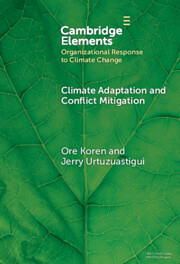Refine search
Actions for selected content:
417 results
9 - Revolution and Intervention, 1917–1920
-
- Book:
- Distant Friends and Intimate Enemies
- Published online:
- 30 October 2025
- Print publication:
- 20 November 2025, pp 179-195
-
- Chapter
- Export citation
Does Ethnopolitical Exclusion Cause Civil War Onset via Grievances? Evidence from 15 Case Studies
-
- Journal:
- Perspectives on Politics , First View
- Published online by Cambridge University Press:
- 14 November 2025, pp. 1-18
-
- Article
-
- You have access
- Open access
- HTML
- Export citation
Chapter 5 - Context of Human Rights Violations
- from Part II - Explaining Human Rights Violations
-
- Book:
- The Politics of Human Rights
- Published online:
- 12 November 2025
- Print publication:
- 06 November 2025, pp 144-171
-
- Chapter
- Export citation
4 - Loyalty and Patronage
-
- Book:
- Mantle of the Sufi Kings
- Published online:
- 27 November 2025
- Print publication:
- 06 November 2025, pp 113-133
-
- Chapter
- Export citation
10 - Irregular War and Warfare
- from Part II - The Traditional Security Agenda
-
- Book:
- Understanding International Security
- Published online:
- 11 October 2025
- Print publication:
- 30 October 2025, pp 191-209
-
- Chapter
- Export citation
Epilogue
-
- Book:
- Minority Identities in Nigeria
- Published online:
- 26 September 2025
- Print publication:
- 16 October 2025, pp 205-209
-
- Chapter
- Export citation
One Cross, Two Continents: How Catholic Women’s Resistance in Mexico Inspired Their Spanish Counterparts (1926–1936)
-
- Journal:
- Comparative Studies in Society and History , First View
- Published online by Cambridge University Press:
- 26 September 2025, pp. 1-22
-
- Article
-
- You have access
- Open access
- HTML
- Export citation
Chapter 6 - Metasecurity Dilemmas in John Milton’s Late Poems
-
- Book:
- Security, Fiscal Policy, and Sovereignty in Renaissance English Literature
- Published online:
- 04 September 2025
- Print publication:
- 18 September 2025, pp 161-202
-
- Chapter
- Export citation
Claiming pietas: Vergilian Rhetoric in Valerius Flaccus’ Argonautica
-
- Journal:
- The Journal of Roman Studies , First View
- Published online by Cambridge University Press:
- 15 August 2025, pp. 1-25
-
- Article
-
- You have access
- Open access
- HTML
- Export citation
Making stars align: Partnerships between state sponsors and armed groups
-
- Journal:
- European Journal of International Security , First View
- Published online by Cambridge University Press:
- 14 July 2025, pp. 1-18
-
- Article
-
- You have access
- Open access
- HTML
- Export citation
Chapter 29 - The German Stage
- from Part IV - Performance Legacies
-
-
- Book:
- Sean O'Casey in Context
- Published online:
- 23 June 2025
- Print publication:
- 10 July 2025, pp 318-328
-
- Chapter
- Export citation
Chapter 2 - The Irish Revolution
- from Part I - Key Places and Events
-
-
- Book:
- Sean O'Casey in Context
- Published online:
- 23 June 2025
- Print publication:
- 10 July 2025, pp 22-34
-
- Chapter
- Export citation
Chapter 3 - On Huecos and Desaparecidos
- from Part I - Shifting Coordinates
-
-
- Book:
- Latinx Literature in Transition, 1992–2020
- Published online:
- 19 June 2025
- Print publication:
- 03 July 2025, pp 59-75
-
- Chapter
- Export citation
4 - Periodicals, 1866–1914
-
- Book:
- Slavery in the International Women's Movement, 1832–1914
- Published online:
- 19 May 2025
- Print publication:
- 05 June 2025, pp 124-178
-
- Chapter
-
- You have access
- Open access
- HTML
- Export citation
Chapter 4 - Consulars under Caesar’s Rule and in the Triumviral Period (49–31)
-
- Book:
- The Role of Ex-Consuls in Republican Rome, 218–31 BCE
- Published online:
- 01 May 2025
- Print publication:
- 15 May 2025, pp 193-209
-
- Chapter
- Export citation
Civilian Harm and Military Legitimacy: Evidence from the Battle of Mosul
-
- Journal:
- International Organization / Volume 79 / Issue 2 / Spring 2025
- Published online by Cambridge University Press:
- 01 July 2025, pp. 332-357
- Print publication:
- Spring 2025
-
- Article
-
- You have access
- Open access
- HTML
- Export citation

Climate Adaptation and Conflict Mitigation
- The Case of South Sudan
-
- Published online:
- 21 April 2025
- Print publication:
- 12 June 2025
-
- Element
- Export citation
Chapter 18 - The Work of War
- from Part V - Labor
-
-
- Book:
- Latinx Literature in Transition, 1848–1992
- Published online:
- 10 April 2025
- Print publication:
- 17 April 2025, pp 315-332
-
- Chapter
- Export citation
4 - Ireland’s Accession to the League of Nations
-
- Book:
- An International Anomaly
- Published online:
- 23 March 2025
- Print publication:
- 03 April 2025, pp 125-178
-
- Chapter
-
- You have access
- Open access
- HTML
- Export citation
Opportunistic rebel tactics in civil war: Evidence from Colombia
-
- Journal:
- Political Science Research and Methods , First View
- Published online by Cambridge University Press:
- 20 March 2025, pp. 1-19
-
- Article
-
- You have access
- Open access
- HTML
- Export citation
